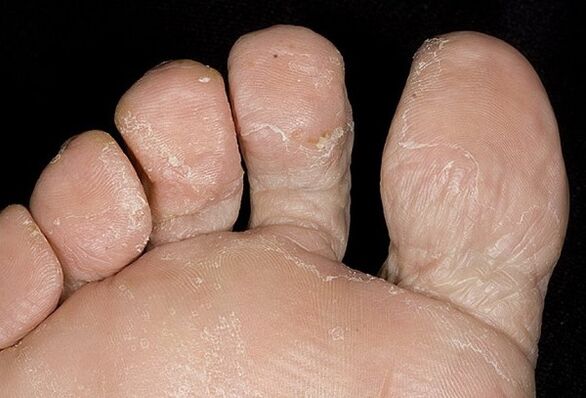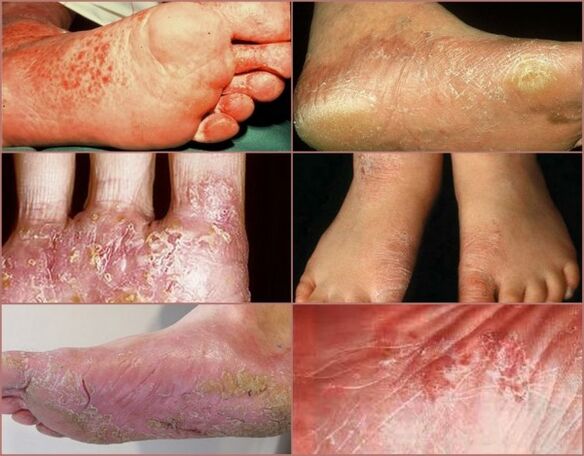The fungus of the skin of the feet in the photo and in life looks ugly.It creates many problems not only with appearance, unpleasant odor and constant discomfort, but can cause severe fungal infections that spread far beyond the foot.
What does the fungus of the legs, toes, nails in the photo
The appearance of the fungus is varied - it depends on the type of pathogen, the characteristics of the skin, the statute of the limitations of the disease, the conditions in which the patient lives, the characteristics of his hygiene regimen.The main areas of lesion are nails, folds between fingers and sole.
The affected nails (onychomycosis) usually have an unbridled appearance yellow, uneven edge, increased fragility, which is why they break down.Often the nails become convex, but this also happens unevenly.
The interrupted folds are an area where high humidity is almost constantly preserved.They are affected by people who wear uncomfortable or not corresponding meteorological shoes.With constant secretion of sweat, fungus reproduction is activated and red spots appear, reminiscent of shifts, yellowish shiny bark, blood wounds with white raid.
The lesion of the sole is characterized by peeling of the skin over the entire surface, loading, layered.At the same time, there may be inconvenience of walking, increased sweating, which further stimulates the growth of fungi.
Types of fungus on the legs

Mycosis (fungal diseases) of the legs are varying due to the fact that they are caused by different pathogens.Depending on the type of fungus and the skin characteristics, several types of diseases are distinguished.
Rubrophytia is called tr.Mental- Extremely contagious sponge that lives in wet rooms (public bathrooms, pools).A characteristic feature is peeling and redness of the skin, swelling of the legs, itching and combs, bleeding easily occurs with damage.
Candidiasis is an infection with a fungus of the genus Candida, which is the most common pathogenic fungus.The lesion of interdigital folds and soles is characteristic.There is severe itching, pain, peeling of the skin.Under exfoliated scales you can see erosion with a white attack.
Onychomycosis is a nail damage, which can have a different severity.The skin lesion, less deep than Rabrofytium, is called epidermophyte.It is characterized by unexplained swelling, but noticeable peeling of the skin.
Stages of development
Regardless of the type of pathogen, the fungus takes place in its development in several stages:
| Initial stage | The pathology is similar to the stratified legs - itching, dryness and peeling of the skin, small cracks appear, swelling is possible. |
| The average stage | Active exfoliation of large layers of skin, the appearance of spots of different hues, severe swelling, itching and maceration (combs) on the skin. |
| Tough | Deep cracks from which the blood can be released, an abundance of skin of the skin, the appearance of deep skin defects and foci of a secondary infection. |
The lesions of refusal continue according to such a scheme - at the beginning the edge of the nails is influenced, then the gray paths appear all over the nail, thickens, becomes fragile, changes color (yellow, white or black).
Symptoms of fungal diseases of the feet
The most conventional symptom of fungal damage to the foot is severe itching.In the early stages of the disease, it is only present when walking or finding in uncomfortable "incomplete" shoes that stimulate sweating.Then it becomes constant and very strong.The procedure for water or pumice can alleviate the condition, but their effect is temporary.
The second bright symptom is skin detachment.It is expressed, sometimes reaching catastrophic size when large layers of the skin are exfoliated.But it can be more pronounced by nature - the constant exfoliation of the scales, which captures a growing area of the foot.
Changing the shape of the nails with onychomycosis - the nails become thick and brittle.The layer, located under the nails (hyperkeratosis), breaks down when the nails are cut.In some cases, it is possible to loosen the nail in the nails, in difficult situations - loss.A new nail in its place grows with hyperkeratosis and "paths", irregular shape.
Initial stage
The fungus of the skin of the feet, whose photo can be seen later, is distinguished by gradual development.Therefore, in the early stages, the disease may not manifest itself in any way.The first signs are quite non -specific - itching during long walking, skin accumulation, the appearance of peeling scales on the soles.Nail fungus does not manifest in a long time than the fungus of the skin.
Some signs that you can suspect the sponge:
- The condition of the skin worsens after the pool, sauna, fitness or other place with high humidity and a large number of visitors;
- Itching is enhanced in a humid environment;
- Skin pigmentation has changed - spots appeared;
- Peeling appears unevenly all over the leg, concentrating more in the area between the toes and the sole;
- Similar symptoms are observed at the same time among several people who together visit places with a possible infection or live in the same apartment.
Interdard
This form is the most unpleasant for the patient.The main location of the lesions is the folds between the fingers, most often 3 and 4 of the finger suffer, more rarely -the folding between 1 and 2. This is related to the characteristics of the structure of the sole.For fungi, high temperature and humidity conditions are optimal, while minimal air exposure or mechanical factors that can remove the fungi.
Such conditions are created in folding between 3 and 3 fingers - the least mobile of all.
Characteristic symptoms - itching and burning at the site of the lesion, the appearance of the skin of the friction -like lesions, with the progression of the disease, they become inflammatory ulcers covered with white coating.Touching them is extremely painful, the symptoms of the disease are exacerbated in hot weather, in uncomfortable shoes and with an increase in humidity.
How is the plaque-hyperkeratotic scene
This stage is characteristic of diseases that affect the sole.Its most bright symptoms are expressed peeling of the skin, its excessive keratinization.The soles look rough, the sensitivity of the skin decreases, touching it becomes unpleasant.Scales are exfoliated from large layers or vice versa, their separation happens with difficulty, while the skin is possible.
The legs affected by fungi, calluses, calluses and other pathological phenomena occur easier.Walking becomes uncomfortable - during a long stay in shoes, itching and leg pain intensifies.

Grain
It is characterized by a change in sweating.None of the fungi species can precipitate in the sweat gland, but indirectly, affecting the epidermis, the inflammatory process disrupts sweating.
The peculiarity of this form is the formation of large bubbles on the skin that easily blends with each other.Most often, the disease begins with the form of an inter -bagbol and has a severe course as progress.
The second characteristic characteristic is the abundant sweating and the unpleasant odor of the leg.The soles have apocrine (distinguished sweat) sweat glands), this explains more than in the open areas, the smell even in healthy people.Due to the fungus, sweating increases, therefore the odor increases.
Diagnosis of Foot Fungus
The skin fungus, whose photo will be given below, has characteristic external manifestations, so the dermatologist begins the diagnostic process by examining the affected limb.This procedure should be performed exclusively in gloves, as there is a high risk for the doctor to become infected by the patient.
The information obtained during the inspection clarifies the history of the anamnesis - a visit to places where fungi, wearing foreign shoes or living in the same apartment with a sick person.
For a more accurate diagnosis, a microbiological examination is performed - a small fragment of the skin, a nail or a separate bubble is collected in a sterile container and then examined under a microscope.Such analysis takes time, therefore it is performed to confirm or correct the treatment regimen or in cases where the appearance of fungi raises doubts.
Effective treatments
The main task of treatment is to eliminate pathogen.To do this, various products are used to apply to the affected skin or taken inside.Treatment is mandatory for all family members to exclude re -infection.
For the same purpose, the patient should be accustomed to complying with the rules of personal hygiene and caution when visiting public places where you can get infected with a sponge.
In therapy, the fungus should in no case use antibiotics - these drugs cause the death of bacteria and release the living space for fungi, thus aggravating the patient's condition.But good effect is given by products that increase immunity as the fungus is part of normal skin of the skin.
Pharmaceutical products good and cheap ointments
The fungus of the skin of the feet is treated completely.The main thing you need to do is remove the pathogen.
For this, antifungal ointments are used - they are applied directly to the skin and affect the affected area of the foot.In addition, they do not cause systemic side effects, ie.They are not absorbed in the blood.
The ointment is applied to the skin after washing the legs, the amount of application 3-8 per day, depending on the intensity of the process and the type of ointment.The tool does not need to be washed, but it should be allowed to be absorbed (5-10 minutes) before wearing socks and shoes.
There are healing varnishes to fight the nail fungus.They are colorless and have no odor.The elbow covers the nails with a layer of medicinal substance, which is kept for one day, is not washed with water, is not washed and does not require update during the day.This allows people who have a strict work schedule or those who are sick on vacation.
In order to enhance the effect of antifungal ointments, it is recommended to treat the skin with topical antiseptics - myramistine, alcoholic solutions of pine and salicylic acid, hydrogen peroxide, chlorhexidine.
Preparation for internal use
The use of oral drugs is shown in cases where the disease has acquired a severe course, widespread or the patient is not able to treat the feet with antifungal agents with sufficient frequency.Also, medicines can be prescribed to boost immunity.
The skin fungus, which is presented in the photo, is treated with antifungal pills.They are used in combination with ointments or as an independent tool.Which instrument is shown in this case, the doctor decides.
With the development of complications of the fungi, hospitalization and the introduction of the same drugs may be necessary.
With complex therapy, anti -inflammatory tablets, medicines to increase immunity and other medicines at the discretion of the specialist may be prescribed.The purpose of their their resistance to pathogenic influences is the purpose of their resistance and to increase the effectiveness of antifungal treatment.
Folk remedies against fungi
Folk remedies for the fight against fungi are also based on anti -inflammatory and disinfectant.For their bigger part, these are leg baths based on various healing fees.Their effectiveness is more than pharmacy drugs, but allows you to improve your patient's health.Before using them, it is advisable to consult a doctor so as not to reduce the overall effectiveness of treatment.

The fungus of the skin of the legs (the photo below shows how unattractive the problem looks if left untreated) is successfully eliminated by baths with cellan or calendula.For this purpose, plant raw materials are insisted in boiling water, the resulting mixture is filtered and dissolved in warm water.The bathroom temperature should be such that the patient is comfortable to lower his legs into it.
As additional components, you can add chamomile, birc, plantan and wormwood.
There are also recommendations for the use of laundry powder (each) as a major therapeutic component of the bathroom, lubricates affected areas with BF glue as well as iodine or vinegar.It must be remembered that folk recipes require caution in circulation so that health is not harmful.
Prevention
In order to avoid infection with a fungus, several simple rules must be observed:
- Observe the rules of personal hygiene - the legs should be clean and dry, you should use the cream for dry skin;
- Wear comfortable socks and shoes that match time, choose "breathable" materials that create comfortable skin conditions;
- When visiting pools, public baths and other places where you can get infected with a sponge, use pool slippers and after you return home to wash your feet;
- Use only your hygiene accessories - towels, pedicure scissors;
- If the fungus is found, the whole family should be treated, whether the symptoms have appeared.
The good result is hardening and other procedures that strengthen the immune system.This avoids the development of a fungal infection during infection.It is important to monitor nutrition - getting enough protein and vitamins maintains immunity, and excess sweets can stimulate the growth of fungi.
Photos of the skin of the skin of the feet seem repulsive, but this disease is treatable with the right approach.It can be cured quite quickly (within 1-2 weeks).If the complications have not developed, then the patient may undergo a course of treatment without interrupting the work and resting.Hospitalization is only required in the most severe and advanced cases in patients with disorders of immunity.
















